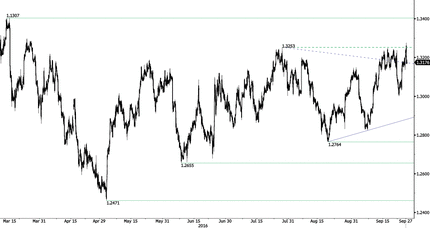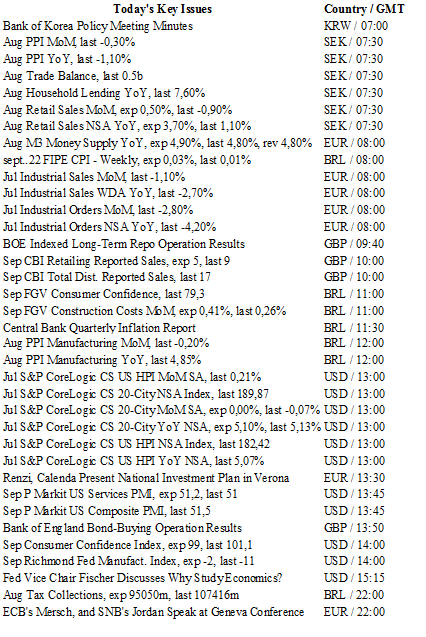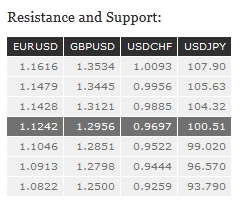TRY recovers despite Moody’s cut
The Turkish lira was heavily sold off yesterday, after Moody’s downgraded the country’s debt to junk. The rating agency cut the long-term issuer and senior unsecured bond rating by one notch, to Ba1, from Baa3, with a “stable” outlook. The decision came on the back of July's failed coup and mounting political instability. Unlike S&P, who cut Turkey's credit to junk two days after the failed coup, Moody’s took its time before coming with a complete review.
The relatively muted reaction of financial markets to Moody’s decision suggests that market participants were broadly expecting the decision. Turkey is now in a difficult situation as the pressure from international investors will continue to increase over the next few months against the backdrop of collapsing growth (GDP growth slowed to 3.1%y/y in the second quarter, compared to 4.7% in the March quarter), continued upside inflationary pressures (CPI rose 8.8%y/y in July, compared to 6.57% in April) and risks to the current account balance stemming from pressure to boost spending.
Even though we believe that another credit cut is not off the table, the Turkish lira should weather the turmoil well, as investors across the globe are still desperately seeking higher returns. Moreover, with the Fed sidelined until at least the end of the year, the pressure should be manageable. USD/TRY eased at around 2.97 this morning and continued to trade with a downside bias.
FX sensitivity to US politics increases
Judging by yesterday's currency price action, it is clear that the FX market was tuned in to the US presidential race. USD, CAD, JPY and MXN were highly sensitive to almost every word uttered during the Clinton – Trump first televised debate. Overall, Clinton’s strong performance removed much of the anxiety and caused USD to come under steady selling pressure. Meanwhile, NAFTA linked currencies CAD and MXN saw heavy buying. Recent polls suggest that the US presidential elections are going to be a coin-toss, indicating the great influence November 8 will have on the financial markets (especially since the focus on monetary policy has taken a pause).
On the data front, August US new home sales dropped by 7.6% m/m to 609k, slightly above consensus of 600k. The drop was in part due to the surge of new homes sales in July, indicating that housing remains solid. Today’s focus will be on US consumer confidence which is expected to moderate from July's strong read, yet indicating that the US consumer remains in good shape.
Finally, Fed vice chair Fischer is expected to speak. However, after the last round of Fed communication which misled the markets into temporarily pricing in a 25bp rate hike, the sensitivity to rhetoric has declined sharply. Moving forward we don’t anticipate any event that will pull the FX markets form its current theme and directions. We remain bearish on USD and see rallies as an opportunity to reload short positions.
USD/CAD - Break key resistance at 1.3253. 

The Risk Today
EUR/USD recovery rally has faded below declining trend line at 1.1292. Hourly support is given at 1.1196 (23/09/2016 low). Key resistance is given at 1.1352 (23/08/2016 high) then 1.1428 (23/06/2016 high). Strong support can be found at 1.1046 (05/08/2016 low). Expected to decline towards 1.1100. In the longer term, the technical structure favours a very long-term bearish bias as long as resistance at 1.1714 (24/08/2015 high) holds. The pair is trading in range since the start of 2015. Strong support is given at 1.0458 (16/03/2015 low). However, the current technical structure since last December implies a gradual increase.
GBP/USD is back below 1.300 after a weak attempt at declining trendline. Persistent selling pressure suggest further weakness. Hourly resistance is given at 1.3121 (22/09/2016 high). Key resistance lies at 1.3445 (06/09/2016 high). Hourly support can be found at 1.2947. Expected to show continued downside pressures. The long-term technical pattern is even more negative since the Brexit vote has paved the way for further decline. Long-term support given at 1.0520 (01/03/85) represents a decent target. Long-term resistance is given at 1.5018 (24/06/2015) and would indicate a long-term reversal in the negative trend. Yet, it is very unlikely at the moment.
{{3|USD/JPY}} rally remains weak below hourly resistance at 101.24. A break of this level is needed to suggest something more than a temporary rebound. Strong resistance can be found at 104.32 (02/09/2016 high) while hourly resistance is given at 102.79 (21/09/2016 high). Psychological support at 100 is not far away. A key support lies at 99.02 (24/06/2016 low). Expected to further weaken. We favour a long-term bearish bias. Support is now given at 96.57 (10/08/2013 low). A gradual rise towards the major resistance at 135.15 (01/02/2002 high) seems absolutely unlikely. Expected to decline further support at 93.79 (13/06/2013 low).
USD/CHF has bounced close to the strong support at 0.9632. However, as long as prices remain below the resistance at 0.9885 (01/09/2016 high), the short-term technical structure is negative. There are alternating periods of strong and low volatility and the pair seems without direction. Next resistance lies at 0.9956 (30/05/2016 high). In the long-term, the pair is still trading in range since 2011 despite some turmoil when the SNB unpegged the CHF. Key support can be found 0.8986 (30/01/2015 low). The technical structure favours nonetheless a long term bullish bias since the unpeg in January 2015.

